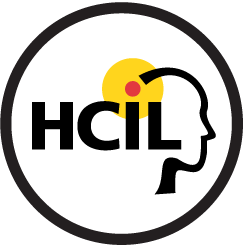Menu
Current Position
Retired Emeritus Professor (no longer taking students or visiting researchers): Computer Science, UMIACS
Founding Director: Human Computer Interaction Lab (1983-2000)
Affiliate Professor: Institute for Systems Research
Affiliate Professor: College of Information Studies - Maryland's iSchool
Research Interests
Human-Computer Interaction, User Interface Design, Information Visualization, Social Media, and Human-Centered AI
Academic Degree
Ph.D., SUNY at Stony Brook, 1973
New Books
-
Shneiderman, B., Human-Centered AI , Oxford University Press (2022):
Recent Honors
- HCI International 2022 Conference “HCI Medal for Societal Impact” on January 26, 2022
- Honorary Doctorate of Science, University of Pretoria on September 4, 2018
- Honorary Doctorate of Science, Swansea University on July 27, 2018
- Honorary Doctorate of Engineering, University of Melbourne on December 13, 2017
- Commencement Address and Citation: Reach High, Be Generous:
- Fellow of National Academy of Inventors (NAI) on December 15, 2015
- CMNS Announcement
- UMD CS Department Announcement
- ISR Announcement
- Honorary Doctorate of Science from Stony Brook University on May 21, 2015
- Stony Brook Press, Street Insider
- UMIACS Announcement
- Video Announcement, YouTube
- Newsday Article
- Stony Brook University Commencement Address
- Opening reception and panel discussion for the Treemap Art Project at the National Academy of Sciences in DC on October 16, 2014. The exhibit “Every AlgoRiThm Has ART in it” includes a 20-page catalog.
- University of Maryland selected Ben Shneiderman as a Distinguished University Professor in 2013.
- The Graduate School of University of Maryland awarded Graduate Faculty Mentor of the Year Award for 2013 to Ben Shneiderman in April, 2013.
- IEEE Computer Society Visualization & Graphics Technical Committee awarded the 2012 Visualization Career Award to Ben Shneiderman in 2012.
- Honorary doctorate from Univ. of Castilla-La Mancha, Spain awarded to Ben Shneiderman on February 9, 2010.
- International Journal of Human-Computer Interaction publishes a special issue in honor of Ben Shneiderman's 60th birthday in 2007.
- National Academy of Engineering elected Ben Shneiderman as a new member on February 17, 2010.
Short Biography
Ben Shneiderman (wikipedia, resume) is a Distinguished University Professor in the Department of Computer Science, Founding Director (1983-2000) of the Human-Computer Interaction Laboratory, and a member of the Institute for Advanced Computer Studies at the University of Maryland, College Park. According to Google Scholar he is the most cited faculty member at the University of Maryland College Park.
He was elected as a Fellow of the Association for Computing (ACM) in 1997 and a Fellow of the American Association for the Advancement of Science (AAAS) in 2001. He received the ACM SIGCHI Lifetime Achievement Award in 2001. He is a member of the National Academy of Engineering, and a Fellow of the National Academy of Inventors in 2015. He received the ACM SIGCHI Lifetime Achievement Award in 2001 and the IEEE Visualization Career Award in 2012.
He was elected a member of the National Academy of Engineering in 2010 in recognition of his pioneering contributions to human-computer interaction and information visualization. His contributions include the direct manipulation concept, which led to clickable highlighted web-links, the ubiquitous touchscreen keyboards on mobile devices, dynamic query sliders for data exploration, and a patent for photo tagging. His work on information visualization led to the widely used treemaps (treemap history, treemap art project), novel network visualizations for NodeXL, and temporal event sequence analysis for electronic health records with EventFlow.
Ben Shneiderman pioneered the highlighted textual link in 1983, and it became part of Hyperties, a precursor to the web. His move into information visualization spawned the commercially successful Spotfire, known for pharmaceutical drug discovery and genomic data analysis.
He has received Honorary Doctorates from the University of Guelph (Canada) in 1995, the University of Castile-La Mancha (Spain) in 2010, Stony Brook University (USA) in 2015, and the University of Melbourne (Australia) in 2017.
Ben Shneiderman is the author of the breakthrough book: Software Psychology: Human Factors in Computer and Information Systems(1980). In 1986, the first edition of Designing the User Interface: Strategies for Effective Human-Computer Interaction was published. Its wide use led to new editions (6th edition, 2016) and translation into 6 languages. This book is popular for his list of "Eight Golden Rules of Interface Design" which is frequently taught in Human-Computer Interaction courses.
He co-authored Readings in Information Visualization: Using Vision to Think (1999) with S. Card and J. Mackinlay. His book, Leonardo's Laptop: Human Needs and the New Computing Technologies (2002), won the IEEE Award for Distinguished Literary Contribution in 2003. He coauthored Analyzing Social Media Networks with NodeXL: Insights from a Connected World (2011), with D. Hansen and M. A. Smith. He wrote The New ABCs of Research: Achieving Breakthrough Collaborations (2016) and the related Rock the Research: Your Guidebook to Accelerating Campus Discovery and Innovation (2018).
A Pioneer in Human-Computer Interaction
Visit the Human-Computer Interaction Lab
Oracle Health Sciences Institute and University of Maryland
Ben Shneiderman's Research Interests
Ski Greeting
New ABCs of Research



 Visit the Treemap Art Project
Visit the Treemap Art Project